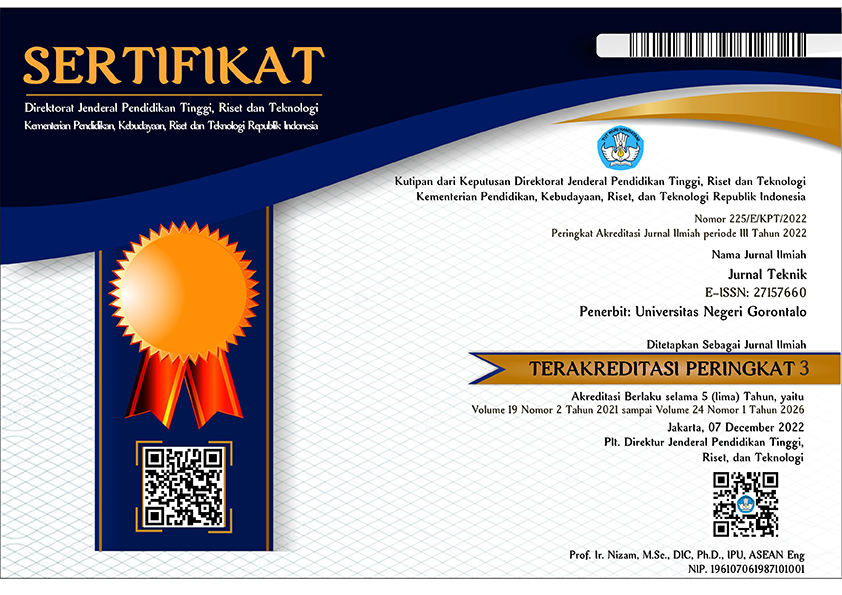Peningkatan Kapasitas Simpang Sebidang Satu Arah dengan Simulasi Lalu Lintas Zero Point
Abstract
The Zero Point intersection is the zero point of Manado City which is also the transfer point for public transportation passengers. The land use around this location is offices, pharmacies, shops, places of worship, hotels and there are also street vendors. This research is to analyze the characteristics of Zero Point intersections using the 2014 Indonesian Road Capacity Calculation (PKJI) method and the PTV Vissim application simulation to obtain alternative solutions.The results of the analysis are that the highest traffic volume (Q) occurred on Monday at 6493.4 cur/hour, vehicle capacity (C) was 2900 cur/hour, the degree of saturation (DJ) was 1,329, the intersection delay value (T) was 376,6 seconds/currency and the Level of Service (LOS) of the unsignaled intersection is at level D which indicates poor intersection performance.The results of this analysis then looked for alternative solutions by trial and error and the chosen alternative was to improve the performance of unsignalized intersections, namely the first was to change the vehicle's turning direction from the direction of Jl. Sudirman (next to Bank Sulut) which will turn towards Jl. Sam Ratulangi has to go around the Zero Point roundabout and the second alternative is to make changes, namely making a median or road divider on the Jl. Sudirman (next to Bank Sulut).
Downloads
References
Adinugraha, A., 2019. Evaluasi Kinerja Simpang Tak Bersinyal ( Studi Kasus JL. Tambun Bungai- JL. R.A. Kartini Kota Palangkaraya, Kalimantan Tengah). Jurnal Teknik Sipil.
Ahmad Munawar. (2005). “Dasar-Dasar Teknik Transportasi”. Yogyakarta : Beta Offset.
Amtoro, A.,Bachnas. & Romadhona, P., 2016. Analisis Kinerja Simpang Tak Bersinyal Empat Lengan (Studi Kasus Simpang Tak Bersinyal Empat Lengan Jalan Wates Km.5, Gamping, Sleman, Yogyakarta). Jurnal Teknik Sipil dan Perencanaan.
Anton Subekti, 2005. Pola Pergerakan Penduduk dan Pelayanan Transportasi di Kota Cilacap, Skripsi, Fakultas Geografi UMS.
Badan Pusat Statistik. 2022. Badan Pusat Statistik Provinsi Sulawesi Utara. Accessed Agustus 17, 2022. https://sulut.bps.go.id/indicator/12/45/1/jumlah-penduduk-kabupaten-kota.html
Datu, V. V., 2018. Analisis Simpang Tak Bersinyal Dengan Bundaran (Studi Kasus : Bundaran Tugu Tololiu Tomohon). Jurnal Sipil Statik. 6(6), Hal. 423-430.
Falcocchio, John C, and Herbert S Levinson. 2015. Road Traffic Congestion: A Concise Guide. USA: Springer International Publishing.
Haryadi, D., Tajudin, I. & Muchlisin., 2017. Modul Pembelajaran Traffic MicroSimulation program PTV VISSIM 9. Yogyakarta : Laboratorium Transportasi dan Jalan Jurusan Teknik Sipil UMY.
Juwita, Farida., 2021. Evaluasi Kinerja Simpang Tak Bersinyal Menggunakan PTV VISSIM 9.0 (Studi Kasus Jalan AH. Nsution – Jalan Way Pangabuan – Jalan Tanggamus). Jurnal Teknika Sains, 6 (1), Hal. 44-50.
Kementrian Pekerjaan Umum. (2014) Pedoman Kapasitas Jalan Indonesia (PKJI). Bandung.
Kumaat, Meike., (2013) Analisis Bangkitan Dan Tarikan Pergerakan Penduduk Berdasarkan Data Matriks Asal Tujuan Kota Manado. Semarang: Universitas Diponegoro.
Romadhona, P., Ikhsan, T. & Prasetyo, D., 2018. Modul PT VISSIM. Yogyakarta: Universitas Islam Indonesia.
Sriharyani, L & Hadijah, I. 2016. Analisis Kinerja Simpang Tidak Bersinyal Kota Metro (Studi Kasus Persimpangan Jalan, Ruas Jend. Sudirman, Jalan Sumbawa, Jalan Wijaya Kusuma dan Jalan Inspeksi). Jurnal Program Studi Teknik Sipil, 6 (1), Hal. 8-14.
Sanda Santhy Aprilia. (2019) Analisis Biaya Kemacetan Kendaraan Pribadi Di Titik Zero Point Manado. Jurnal Sipil Statik Vol.7 No.10 Oktober 2019 (1283-1294) ISSN: 2337-6732
Copyright (c) 2024 Semuel Y. R. Rompis, Meike Kumaat (Author)

This work is licensed under a Creative Commons Attribution-ShareAlike 4.0 International License.













